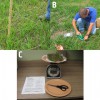 El forraje sirve como fuente primaria de nutrientes para la industria ganadera en Florida. El uso eficiente de esta fuente nutricional es crítico para la supervivencia de los agricultores y rancheros de dicho estado. El estimar la cantidad de forraje en potreros puede proveer información útil a la hora de tomar decisiones acerca del manejo de nuestros recursos. Debe de haber suficiente material en el predio para justificar el costo de utilizar el equipo para cosechar (por ejemplo, precio de compra del equipo, renta, costo del combustible a invertirse, y el costo de la mano de obra). Sin esta información, el predio debe ser sometido a pastoreo. Esta publicación contiene las instrucciones para la implementación de un método simple que nos permite determinar la cantidad aproximada de forraje en campos de heno y potreros.This 2-page fact sheet was written by T. Wilson, C. Sanders, J. Breman, y L. Sollenberger. Traducido por J. Bosques, and published by the UF Department of Agronomy, January 2014.
El forraje sirve como fuente primaria de nutrientes para la industria ganadera en Florida. El uso eficiente de esta fuente nutricional es crítico para la supervivencia de los agricultores y rancheros de dicho estado. El estimar la cantidad de forraje en potreros puede proveer información útil a la hora de tomar decisiones acerca del manejo de nuestros recursos. Debe de haber suficiente material en el predio para justificar el costo de utilizar el equipo para cosechar (por ejemplo, precio de compra del equipo, renta, costo del combustible a invertirse, y el costo de la mano de obra). Sin esta información, el predio debe ser sometido a pastoreo. Esta publicación contiene las instrucciones para la implementación de un método simple que nos permite determinar la cantidad aproximada de forraje en campos de heno y potreros.This 2-page fact sheet was written by T. Wilson, C. Sanders, J. Breman, y L. Sollenberger. Traducido por J. Bosques, and published by the UF Department of Agronomy, January 2014.
http://edis.ifas.ufl.edu/ag379
Tag: Cindy Sanders
Estimating Amount of Forage in Hay Fields and Pastures (SSAGR360/AG369)
 Forage serves as the primary source of nutrients for livestock in Florida, and efficient use of forage is critical to the livelihood of Florida farmers and ranchers. Estimating the amount of forage in a pasture can provide useful information when making management decisions. There must be enough material in the field to justify the cost of using harvesting equipment; otherwise, the area should be grazed. This 2-page fact sheet contains instructions for a simple method to determine the approximate amount of forage in hay fields and pastures. Written by T. Wilson, C. Sanders, J. Breman, and L. Sollenberger, and published by the UF Department of Agronomy, March 2012.
Forage serves as the primary source of nutrients for livestock in Florida, and efficient use of forage is critical to the livelihood of Florida farmers and ranchers. Estimating the amount of forage in a pasture can provide useful information when making management decisions. There must be enough material in the field to justify the cost of using harvesting equipment; otherwise, the area should be grazed. This 2-page fact sheet contains instructions for a simple method to determine the approximate amount of forage in hay fields and pastures. Written by T. Wilson, C. Sanders, J. Breman, and L. Sollenberger, and published by the UF Department of Agronomy, March 2012.
http://edis.ifas.ufl.edu/ag369
Converting the Beef Cow Herd to a Controlled Breeding Season (AN267)
 Implementing a controlled breeding season to manage the length of the calving season is a cost-effective management practice. This 4-page fact sheet describes a 3- to 4-year conversion program beef cattle producers can follow. Written by Tim Wilson, Cindy Sanders, Mark Warren, Matt Hersom, and Curt Lacy, and published by the UF Department of Animal Science, August 2011.
Implementing a controlled breeding season to manage the length of the calving season is a cost-effective management practice. This 4-page fact sheet describes a 3- to 4-year conversion program beef cattle producers can follow. Written by Tim Wilson, Cindy Sanders, Mark Warren, Matt Hersom, and Curt Lacy, and published by the UF Department of Animal Science, August 2011.
http://edis.ifas.ufl.edu/an267